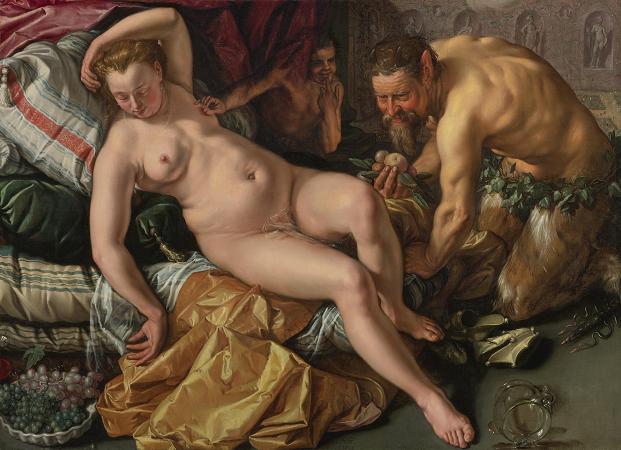Antiope. In Greek mythology, Antiope was the daughter of the Boeotian river god Asopus. One of the most popular themes in the representation of Antiope is her abduction by Zeus, who took the form of a satyr to seduce or rape her. This scene has been depicted by many artists, including Titian, Correggio, and Rubens. Antiope is also often depicted as the mother of her twin sons, Amphion and Zethus. In some representations, she is shown nursing or caring for her infants, while in others, she is shown with her grown sons, who became famous for building the walls of Thebes. Another common theme in the representation of Antiope is her punishment by King Lycus, who ordered her to be tied to a bull or a wild animal as punishment for her alleged infidelity. This scene has been depicted by artists such as Peter Paul Rubens and Nicolas Poussin. In some representations, Antiope is shown as a warrior queen, leading an army of Amazon women into battle. This theme is less common than the others but can be seen in works such as the Antiope Amazon statue by French sculptor Jean-Baptiste Carpeaux. In later sources she is called the daughter of the nocturnal king Nycteus of Thebes or, in the Cypria, of Lycurgus, but for Homer her site is purely Boeotian. She was the mother of Amphion and Zethus. Her beauty attracted Zeus, who, assuming the form of a satyr, took her by force. A.B. Cook noted that her myth took on a Dionysiac colouring, Antiope being represented as a Maenad and Zeus as a Satyr. This is the sole mythic episode in which Zeus is transformed into a satyr. Being pregnant with Zeus' child Antiope feared the wrath of her father, Nycteus, and fled to Sicyon, where she married Epopeus. After this she was carried off by Epopeus, who was venerated as a hero in Sicyon; he would not give her up till compelled by her uncle Lycus. Lycus pursued Antiope after his brother Nycteus committed suicide because of Antiope's disgrace. On the way home she gave birth, in the neighbourhood of Eleutherae on Mount Cithaeron, to the twins Amphion and Zethus, of whom Amphion was the son of the god, and Zethus the son of Epopeus. Both were left to be brought up by herdsmen. At Thebes Antiope now suffered from the persecution of Dirce, the wife of Lycus, but at last escaped towards Eleutherae, and there found shelter, unknowingly, in the house where her two sons were living as herdsmen. This is the situation in Euripides' Antiope, which turns upon the recognition of mother and sons and their rescue of her. Here she was discovered by Dirce, who had come to celebrate a Bacchic festival; she ordered the two young men to tie Antiope to the horns of a wild bull. They were about to obey, when the old herdsman, who had brought them up, revealed his secret, and they carried out the punishment on Dirce instead, for cruel treatment of Antiope, their mother, who had been treated by Dirce as a slave. In Euripides, the descent of Hermes stops the brothers from putting their uncle to death; Lycus then resigns power in the Cadmeia of Thebes to the twins. For the treatment of Dirce, it is said, Dionysus, to whose worship she had been devoted, visited Antiope with madness, which caused her to wander restlessly all over Greece until she was cured, and married by Phocus of Tithorca, on Mount Parnassus, where both were buried in one grave. Amphion became a great singer and musician after Hermes taught him to play and gave him a golden lyre; Zethus was a hunter and herdsman. Amphion and Zethus are said to have established the fortifications of Thebes. For Greeks of the Classical age, the contrast between the lifestyles of the two became the most salient element in the narrative; in Euripides' Antiope the best-recalled scene was where the two brothers in debate contrasted their active and contemplative lives. Together they built and fortified Thebes, huge blocks of stone forming themselves into walls at the sound of Amphion's lyre. Amphion married Niobe, and killed himself after the loss of his wife and children. Zethus married Aedon, or sometimes Thebe. The brothers were buried in one grave. At Sicyon, Antiope was important enough that a chryselephantine cult image was created of her and set up in the temple of Aphrodite. Pausanias speaks of it. Only one priestess, an elderly woman, was permitted to enter the cella of the temple, with a young girl chosen each year, to serve as Lutrophoros.
more...







